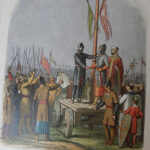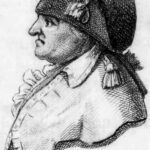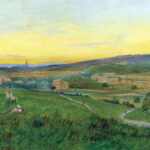15 July 1802: In the Hambleton Hills, Dorothy and William Wordsworth visit Rievaulx Abbey and see London-bound Scottish cattle
Dorothy Wordsworth. 1897. Journals of Dorothy Wordsworth, Vol. 1. Ed. William Knight. London: Macmillan and Co. Get it:
.Excerpt
The day was very hot, and we rested often and long before we reached the foot of the Hambleton Hills, and while we were climbing them, still oftener. We were almost overpowered with thirst, when I heard the trickling of a little stream of water. I was before William, and I stopped till he came up to me. We sate a long time by this water, and climbed the hill slowly. I was footsore; the sun shone hot; the little Scotch cattle panted and tossed fretfully about. The view was hazy, and we could see nothing from the top of the hill but an undistinct wide-spreading country, full of trees, but the buildings, towns, and houses were lost. We stopped to examine that curious stone, then walked along the flat common. Arrived very hungry at Rievaulx. Nothing to eat at the miller’s, as we expected, but at an exquisitely neat farmhouse we got some boiled milk and bread. This strengthened us, and I went down to look at the ruins. Thrushes were singing; cattle feeding among green-grown hillocks about the ruins. The hillocks were scattered over with grovelets of wild roses and other shrubs, and covered with wild flowers. I could have stayed in this solemn quiet spot till evening, without a thought of moving, but William was waiting for me, so in a quarter of an hour I went away. We walked upon Mr Duncombe’s terrace and looked down upon the abbey. It stands in a larger valley among a brotherhood of valleys, of different length and breadth – all woody, and running up into the hills in all directions.
Comment
Comment
Via William Addison, who comments re the “little Scotch cattle”:
They would be travelling along the Bronze Age track that mounted the Cleveland Hills at Scarth Nick after crossing the Tees near Yarm, to continue along a ridgeway over Osmotherley Moor to reach eventually Cooper Cross at the head of Sutton Bank. It would be along this green road that old Mr Jorrocks ‘encountered a large drove of Scotch kyloes picking their way as they went’.
his road was favoured not only because it avoided the rough roads of Yorkshire that were then notorious for being surfaced with loose sharp stones that could cripple a beast; but also because it bypassed turnpikes. After passing through Laurence Sterne’s Coxwold, however, it had to join the Great North Road in the end, although without doubt the Turnpike Trusts extended the use of green roads-they were hardly lanes- long after the coach roads had been metalled. On reaching the highway, the drovers made their way to cattle farriers, some of whom did lively business shoeing cattle. One at Langthorpe, near Boroughbridge, claimed that he went through 30,000 special nails used in shoeing bullocks during the course of a year. Some smiths boasted that they could shoe 70 beasts a day. As 30,000 cattle a year were said to pass through Wetherby that also must have been a prosperous town for shoeing smiths, yet comparatively few of these shoes, called ‘cucs’ or ‘kews’, are dug up in the countryside-perhaps because they were made in two parts to fit cloven hoofs, so are not recognised for what they are. As in so many fields of North Country research, the man to go to when in search of information about the drove roads of the North is Arthur Raistrick, whose Green Roads on the Pennines is an invaluable guide.
One of the greatest cattle dealers using these roads was Ralph Robb of Topcliffe, near Thirsk, who in the early years of the nineteenth century travelled to Falkirk Fair with £30,000 in Bank of England notes in his wallet, and returned with 12,000 head of cattle, having drawn bills for the balance of their price.† But the king of the cattle country in the North was John Birtwhistle of Skipton, who fattened his stock in the Great Close of Malham Moor during the second half of the eighteenth century. This grazing ground was a vast enclosure of 732 acres, in which as many as 5,000 head of cattle could be grazing at any one time. It was estimated that in addition to those in the Great Close, Birtwhistle might often have as many as 10,000 head of cattle somewhere on the drove roads.
[Maps]
This droving business could not fail to have its effect on dairy farming in the dales, and because there were no large towns within reach for the daily distribution of milk in those days, Yorkshire became famous for its cheeses. These were sold in the markets of Settle, Skipton, Hawes, Richmond, Bishop Auckland, and Barnard Castle, while the butter was collected by higglers and sold to grocers.
Its wide grass verges, which made the Great North Road so much more attractive than other main roads, were obviously due to its use as a drove road. There are no accurate figures of the number it carried, but it is claimed that at the height of the droving business 2,000 cattle passed through Boroughbridge daily. However, when careful counts were made at Wetherby Bridge in 1779 from 6 August to 25 November, the total number was 21,248, which although more than 1,300 weekly makes the Boroughbridge claim more than a little inflated. Some of the farmers who let out fields for travelling flocks and herds planted small clumps of Scotch firs near their farmhouses as signs that they had pasture to let, and were well disposed towards Scots.
(Addison 1980).
Wordsworth’s “Millers”: presumably not a family but the proprietor of the village mill, which was ornamented with “some fine specimens of corbels, probably from the nave” (T. 1845).
Something to say? Get in touch
Original
On Thursday morning, at a little before seven, being the 15th July, we got into a post-chaise and went to Thirsk to breakfast. We were well treated, but when the landlady understood that we were going to walk off, and leave our luggage behind, she threw out some saucy words in our hearing. The day was very hot, and we rested often and long before we reached the foot of the Hambledon Hills, and while we were climbing them, still oftener…. We were almost overpowered with thirst, when I heard the trickling of a little stream of water. I was before William, and I stopped till he came up to me. We sate a long time by this water, and climbed the hill slowly. I was footsore; the sun shone hot; the little Scotch cattle panted and tossed fretfully about. The view was hazy, and we could see nothing from the top of the hill but an undistinct wide-spreading country, full of trees, but the buildings, towns,[Pg 143] and houses were lost. We stopped to examine that curious stone, then walked along the flat common…. Arrived very hungry at Rivaux. Nothing to eat at the Millers, as we expected, but at an exquisitely neat farm-house we got some boiled milk and bread. This strengthened us, and I went down to look at the ruins. Thrushes were singing; cattle feeding among green-grown hillocks about the ruins. The hillocks were scattered over with grovelets of wild roses and other shrubs, and covered with wild flowers. I could have stayed in this solemn quiet spot till evening, without a thought of moving, but William was waiting for me, so in a quarter of an hour I went away. We walked upon Mr. Duncombe’s terrace and looked down upon the Abbey. It stands in a larger valley among a brotherhood of valleys, of different length and breadth,—all woody, and running up into the hills in all directions. We reached Helmsly just at dusk. We had a beautiful view of the castle from the top of the hill, and slept at a very nice inn, and were well treated; floors as smooth as ice.
365 words.
Similar
 22 August 1138: King David of Scotland is overtaken near Northallerton by a furious local army in possession of a great standard – a Victorian view
22 August 1138: King David of Scotland is overtaken near Northallerton by a furious local army in possession of a great standard – a Victorian view 2 October 1800: Part of an obituary to Harry Rowe, Punch and Judy man, trumpeter at the Battle of Culloden and the York assizes, who died today, old and ill, in the York poorhouse
2 October 1800: Part of an obituary to Harry Rowe, Punch and Judy man, trumpeter at the Battle of Culloden and the York assizes, who died today, old and ill, in the York poorhouseSearch
Donate
Music & books
Place-People-Play: Childcare (and the Kazookestra) on the Headingley/Weetwood borders next to Meanwood Park.
Music from and about Yorkshire by Leeds's Singing Organ-Grinder.



 Bluesky
Bluesky Extwitter
Extwitter